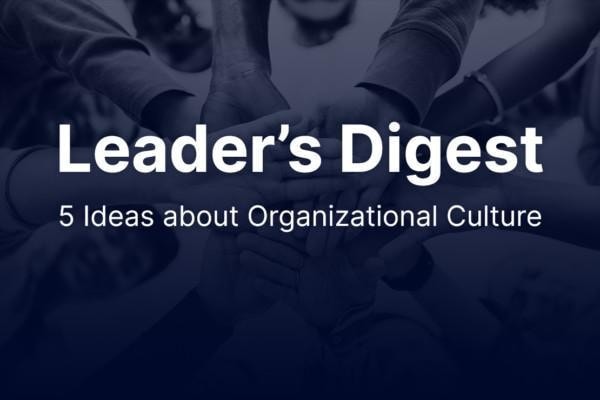22Feb2022
“Company culture is the backbone of any successful organization”, says Gary Vaynerchuck. Do you agree?
We dare to argue that there’s truth to Gary’s argument; organizational culture can be a driving success factor for any business. And, on the other hand, cultural problems can cause the organization to suffer—or even fail. Here, we list 5 powerful ideas from top experts on how to develop a thriving organizational culture.
1. Seek for Cultural Contribution, Not Culture Fit
“Culture fit is good early, and it becomes problematic over time.” – Adam Grant
Culture fit is a common concept in recruiting, but organizational psychologist and author, Adam Grant thinks that we should be more skeptical about it.
“Culture fit is a great proxy for groupthink.” This is why Adam suggests that when recruiting, companies should aim to bring in diverse backgrounds, skills, and thinking, rather than hiring based on who seems to get along with others in the company. He explained that a great example of this is IDEO. When asked by a client to reimagine their shopping cart, IDEO hired an anthropologist who could dive into the new environment and tease out its intricacies. The company continued to diversify its hiring choices with impressive results.
According to Adam, this concept of cultural contribution is a model for rethinking culture. As he puts it, the question in leaders’ minds should be “what is missing from the culture—and is this person going to enrich it, and contribute something that’s absent?”
2. Combine Freedom with Responsibility
“Employee freedom breeds innovation and process kills flexibility.” – Erin Meyer
Netflix’s thriving culture is considered somewhat iconic in the business world. But what are the aspects of its culture that can be considered as the drivers of success?
According to INSEAD Professor Erin Meyer (who also co-wrote the book No Rules Rules with Netflix co-founder and CEO Reed Hasting), it is the combination of freedom and responsibility that resulted in this strong culture.
To cultivate this type of organizational culture, Netflix has taken three purposeful steps:
- Increasing Talent Density—they let adequate employees go and keep and hire top performers.
- Increasing Candor—they encourage and cultivate constant, candid feedback.
- Removing Controls—they got rid of strict policies and processes to empower their people.
Some of it may sound controversial or at least unconventional, but at least for Netflix they seem to work.
3. Cultivate a Culture of Innovation
“You also need to ask yourself: Are you creating an innovation culture in addition to your execution culture? It’s not either-or—it’s and.” – Alex Osterwalder
Innovation expert, author, and entrepreneur, Alex Osterwalder, emphasizes the power of organizational culture when it comes to innovation. “Culture is the key differentiator,” he said. So, how are things in your organization?
To get started, Alex suggests you assess the innovation culture readiness in your organization through three different aspects:
- Leadership Support: How is your leadership supporting innovation?
- Organizational Design: How is your organizational design equipped to support innovation?
- Innovation Practice: How does your innovation practice look like?
In brief, you can assess these aspects by answering the following questions:
- How much time does the CEO spend on innovation, and how much time was spent on innovation in the last several board of directors’ meetings? Alex argues that a CEO should spend 20-40 percent of his or her time on innovation.
- Where does innovation live on your org chart? According to Alex, there cannot be too many layers between those responsible for innovation and the CEO.
- What does your innovation practice—and specifically, your kill ratio—look like? Alex suggests that a higher kill ratio leads to more focused innovation investments.
4. Drive Meaningful Interaction
“The core process of culture-shaping is done in interaction and decision making.” – Jitkse Kramer
According to corporate anthropologist, Jitkse Kramer, in our organizations, there are typically two types of interactions: bullet point meetings and campfire conversations.
Bullet point meetings are used to discuss day-to-day topics, organize, reorganize, and plan. These interactions are necessary but are largely ordinary. Campfire conversations, on the other hand, are the interactions in which real change occurs and culture is shaped. “Around a campfire, we share feelings, dreams, and create new storylines. In those moments, we shape and reshape our cultures.”
Therefore, Jitske encourages leaders to have enough campfire conversations in their organizations in order to drive meaningful interaction. She suggests that we need to have fewer but more meaningful meetings that:
- Are more human and authentic
- Occur in safe spaces
- Create new rituals
- Establish new etiquette
5. Enhance Psychological Safety
“Psychological safety is a belief that the context is safe for interpersonal risk-taking – that speaking up with ideas, questions, concerns, or mistakes will be welcomed and valued.” – Amy Edmondson
According to Harvard Professor Amy Edmondson, fear often stops people from voicing their ideas and opinions. As we don’t want to appear incompetent, intrusive, or negative, we don’t ask questions or share our ideas. This, however, prevents the organization from developing, learning, and innovating. Also, when holding back, people in the company will eventually start to disengage.
To avoid this from happening in your organization, you need psychological safety. In order to give honest feedback, voice concerns, and share new ideas, people need to feel safe.
So what does psychological safety consist of? Amy highlights that it amounts to beliefs about:
- Inclusion and diversity: When people see the team as inclusive, they are more inclined to speak up and contribute to the work.
- Willingness to help: When people see each other as willing to help, they will speak up when they are unsure about something.
- Attitude to risk and failure: When people believe the team blames for mistakes, they will not try new things or report problems.
- Open conversation: When people believe that open and candid conversations are possible, they tackle hard problems together.
At Nordic Business Forum 2022 in Helsinki next September, we will dive deeper into the topic of organizational culture. Erin Meyer, Jitske Kramer, and Amy Edmondson, among others, will step on stage to share their wisdom. Learn more about Nordic Business Forum 2022 on the event website.

 by:
by: 
